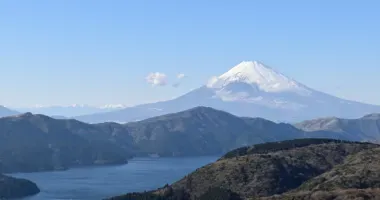Kitaguchi Hongu Fuji Sengen-jinja Shrine 北口本宮冨士浅間神社
Under the protection of Fuji-san
Kitaguchi Hongû Fuji Sengen-jinja Shrine is located in Suwa Forest, Fujiyoshida City. This shrine is part of a set of elements encompassing Mount Fuji and many other buildings, all listed by UNESCO in 2013. It is one of the gateways to climbing the great sacred volcano for centuries, “Fuji Yoshida Guchi”.

Kitaguchi Hongû Fuji Sengen-jinja shrine and the millennial cypress in the foreground
Jerome Laborde
A mountain of desires
Mount Fuji has been a sacred mountain for a very long time, as long as man has existed near it. For centuries, it was forbidden to access it , only admiring it was enough for the happiness of these first residents. Above all, she was scary, getting angry by sometimes spitting ashes, making the earth shake for miles. No one dared to venture on its steep slopes.
Until the day when monks attempted the ascent, out of bravery and for " Sadhana ", spiritual elevation , so that in the Edo period (1603-1868) pilgrimages to Mount Fuji developed. However, the ascent remained forbidden to women until the Meiji era (1868-1912).
Before undertaking the climb to this sacred place, one had to purify oneself , which is why the Fuji Sengen-jinja shrine is important and marks the starting point.
Read: Fujiyoshida
A sanctuary in the heart of fire
The Kitaguchi Hongû Fuji Sengen-jinja Shrine was founded in the year 110 by the way of Yamato Takeru, from the imperial family and hero of Japanese legends. An eruption of Fuji takes place in the year 781 , and in 788 the construction of the temple at the current location begins in order to calm this impetuous volcano , but also to honor the goddess of water and Mount Fuji Kono Hana Sakuya Hime no Mikoto, who gave birth to her children in the fire to show her strength.
With the development of pilgrimages, the sanctuary will be fitted out to receive this influx around the year 1730 by Murakami Kôsei.
On the same theme: 5 pilgrimages to do in Japan

The great alley of Japanese cypresses leading to the sanctuary
Flickr Nao lizuka
A sacred temple so close to you
From the current Fuji-san station, in 15-20 minutes on foot, you can see Mount Fuji right in front of you. Follow your route along a wide alley of Japanese cypresses and century-old cedars , tôrô, stone lanterns covered with moss, solemnly accompany your progress towards the sanctuary. Just this moment is already magical, imbued with a very Japanese grace. Then you arrive in front of the big red torii , the largest wooden torii in Japan, 17 meters high . It is rebuilt every 60 years so that it keeps its superb; the last time was in 2014.
See also: Torii, the Japanese gate
A stream with such refreshing water flows here, reminiscent of the goddess of water, important because every pilgrim purified himself there before climbing the burning slopes of Fuji-san.
Here you are in front of the main building of the Kitaguchi Hongû Fuji Sengen-jinja shrine, on your left the sacred 1000-year-old cypress Fuji Tarô Sugi with the braided rope surrounding its trunk.
A few more steps and you will be in front of the entrance gate marking the starting point for the ascent of Mount Fuji, 850 meters above sea level . From this point 0, you will have about 9 hours of walking to the top. Needless to say that this exercise is not within everyone's reach, you have to be very well trained and equipped to face such an effort. But if you want to do it in the rules of the art, by the sacred way, here you are.

The fire festival marking the closing of the path leading to the summit of Mount Fuji
Wikimedia Commons
Fujiyoshida shines brightly
Mount Fuji is not accessible all the time, far from it, on the contrary, it is the only two months of July and August that open access to the public.
On June 30 and July 1, a religious ceremony marks the opening of the road, while August 26 and 27 mark its closure. During a big celebration, which begins at the Kitaguchi Hongû Fuji Sengen-jinja shrine and over more than 2 kilometers, 70 giant 3-meter torches are lit , as well as the refuges along the route to the summit. The city of Fujiyoshida and the slopes of Fuji-san shine with a thousand lights. This historical tradition has been going on for 400 years , to thank the kami and welcome them in mikoshi to the center of the city.
For further :
- When to climb?
- 7 facts about Mount Fuji
- Feature: Climbing Mount Fuji
- Budget to plan for the ascent
- Five onsen with views of Mount Fuji
- Three little-known caves at the foot of Mount Fuji
- Admire the sunrise and sunset at Mount Fuji
- Mount Fuji in numbers
Address, timetable & access
Address
Phone
+81 555-22-0221Timetable
Sengen jinja mae bus stop, accessible from Kawaguchiko and Fujisan stationsWebsite
http://sengenjinja.jp/english/index.html























